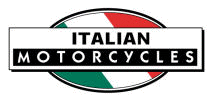


Vittorina Sambri and the Motoborgo Team

Vittorina Sambri, Moto Borgo ca 1914

Motoborgo Factory, Torino 1915

Borgo Sidecar on 1918 Reading Standard
A Brief History of the Marque
Manufactured: 1899-1926
1923 Moto Borgo Corsa 500 V twin OHV cuatro válvulas
Siendo actualmente muy conocida por sus pistones, Borgo (Fabbrica Italiana Velocipedi e Motocicli Borgo, luego rebautizada como Moto Borgo) fue fundada en 1906 por los hermanos Carlo, Alberto y Edmondo Borgo en Torino donde ponen en marcha la producción de algunos diseños avanzados. La primera línea de motocicletas fueron de 498, 693 y 827 cc con válvulas de admisión sobre las de escape (IOE). En 1911 adoptan (y patentan) el uso de pistones de aluminio y en 1914 incorpora un modelo con transmisión por correa con relación variable (copia de la inglesa Rudge Multi) sistema que denominan "Borgo Cambio Graduale". La diferencia con las marcas inglesas era que, en lugar de moverse la rueda trasera para mantener tensionada la correa, en la Borgo se desplazaba toda la parte posterior del cuadro. También presentan un sistema de embrague para arrancar desde parado, algo que era inusual para la época.
En 1915 construyen una 996 cc V-twin y más tarde también habría una versión de 746 cc.
Las motos Borgo ganaron rápidamente fama deportiva, colocando a la marca entre los pioneros del motociclismo deportivo. Edmondo Borgo vence en Cremona en 1912 y el propio Carlo Borgo gana el Gran Premio de Italia (Categoría 350) en 1914
En nuestro país, Juan Von Martin en su libro "Historia del motociclismo argentino" menciona que en 1913 una Borgo 3 ½ HP finalizaba en segundo lugar en la carrera denominada "Campeonato del Kilómetro"
En 1920 comenzaron la producción de un bicilíndrico de 477 cc con el tanque de aceite integrado al de combustible. En 1921 los Borgo construyen un motor de carreras válvulas a la cabeza V-Twin de 496 cc con cuatro válvulas por cilindro que competiría en el Campeonato de Italia en 1923.
Alrededor de 1920 Borgo también comienza a importar en Italia las Reading Standard americanas. La producción de motocicletas cesaría en 1926, cuando la empresa decidió especializarse en la fabricación de pistones.
Founded in Turin, the company built OHV twin-cylinder motorcycles which did very well on the racetrack.
Now well-known for its pistons, Borgo (Italian fabbrica velocipedi and motocicli borgo, later named Moto Borgo*) was founded in 1906 by brothers Carlo, Alberto and Edmondo Borgo in Torino where they produced some advanced designs . The early motorcycles were equipped with IOE 498, 693 and 827 cc engines.
In 1911 they adopted (and patented) aluminium pistons, an idea possibly borrowed from W.O. Bentley, and in 1914 incorporated a model with variable speed transmission by Correa (a copy of the Rudge Multi) that they called the "Borgo graduale change". The difference to the English system was that instead of moving the rear wheel to keep tension on the belt as with the Zenith Gradua, the Borgo moves the whole rear section of the frame backwards and forwards, and this section is pivoted below the saddle. The machine also has a clutch which allows use of the pedaling gear from a standing start, something that was unusual for the time.
In 1915 they built a 996cc V-twin and later would also have a 746 cc version.
Borgo quickly achieved fame in motorcycle racing, placing the brand among the pioneers of the sport. Edmondo Borgo won at Cremona in 1912, and Carlo Borgo won the Italian 350 Grand Prix in 1914.
Juan Von Martin in his book Historia del motociclismo argentino mentions that in 1913 a Borgo 3 ½ hp machine took second place in the Campeonato del Kilómetro in Argentina.
In 1920 they produced a unit-construction 477cc v-twin engine.
It had four valve heads and the oil tank was mounted on the frame rails above the tank (as can be seen in the team photo with Vittorina); in 1921 they built a competition OHV 496 cc V-twin with four valves per cylinder that would compete in the Italian Championship in 1923.
Vittorina Sambri raced Motoborgo machines from 1914 until at least 1922 when she won a round of the 500cc Italian Championship. Prior to that she raced bicycles in 1911 - in 1913 she raced in Paris.
In 1913 she achieved widespread fame after beating a well-known racer, Antoniazzi.
In the 1950s she ran a Moto Guzzi dealership in Ferrara with her brother Romeo, also a champion rider, in via Garibaldi and later in via Borgoleoni. She dressed as a man throughout her working life. It is said that she was gay and was ostracized by members of her family as a result, and even beaten. It seems though that she was well-liked and respected by her fellow riders.
Around 1920 Borgo began to import Reading Standard motorcycles from the United States to which they fitted, quoting Yesterday's NL, "a stunning Italian 'Moto Borgo Torino' family sidecar". The production of motorcycles ceased in 1926, when the company decided to specialize in the manufacture of pistons.
Motoborgo 500cc Racer Specification
V-Twin Engine 45° ohv four valves air-Cooled-494 cm3 (68 x 68 mm), pressure lubrication. 6000 RPM.
Magneto Ignition Bosch
Two speed gearbox in unity with the engine
Final drive by chain
Tubular Frame of crib simple open
Front suspension for parallelogram
Rim brakes
Weight 100 kg
Maximum Speed 120 km/h.
Notes: see Borgo for information on the names and addresses of the Borgo marque
Sources: MC Storico Conti et al
If you have a query about Moto Borgo or have information about these vintage Italian machines, please contact us